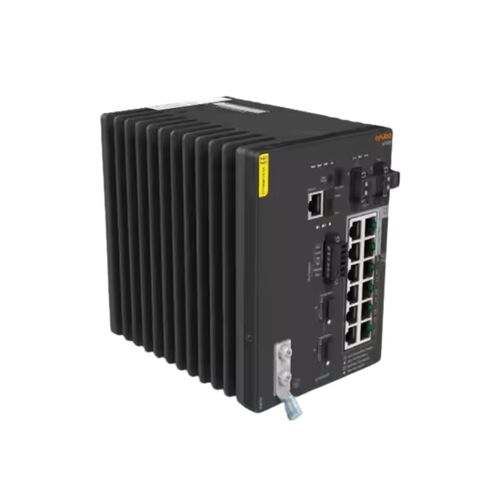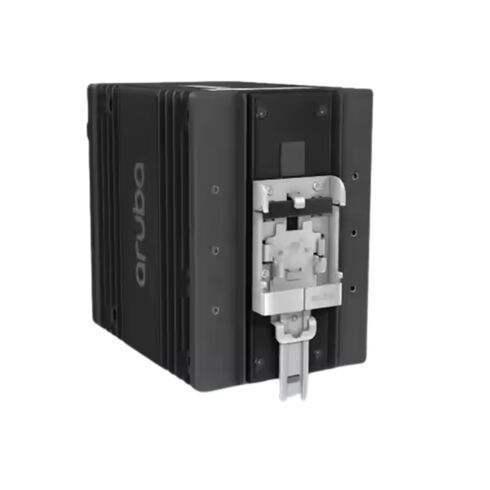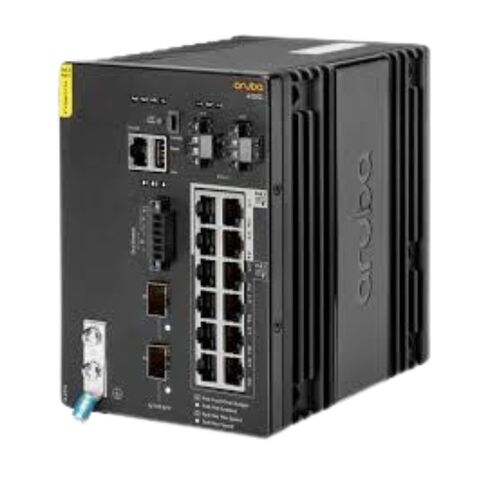JL817-61001 HPE Aruba 4100i Ethernet Managed Network Switches
- — Free Ground Shipping
- — Min. 6-month Replacement Warranty
- — Genuine/Authentic Products
- — Easy Return and Exchange
- — Different Payment Methods
- — Best Price
- — We Guarantee Price Matching
- — Tax-Exempt Facilities
- — 24/7 Live Chat, Phone Support
- — Visa, MasterCard, Discover, and Amex
- — JCB, Diners Club, UnionPay
- — PayPal, ACH/Bank Transfer (11% Off)
- — Apple Pay, Amazon Pay, Google Pay
- — Buy Now, Pay Later - Affirm, Afterpay
- — GOV/EDU/Institutions PO's Accepted
- — Invoices
- — Deliver Anywhere
- — Express Delivery in the USA and Worldwide
- — Ship to -APO -FPO
- — For USA - Free Ground Shipping
- — Worldwide - from $30
Overview of the 12-Port Managed Ethernet Switch
Manufacturer and Model Details
- Brand: HPE
- Model: JL817-61001
- Device Category: Managed Ethernet Switch
Key Technical Features
Port Configuration
- Total Ports: 12
- Breakdown:
- 8 x 10/100/1000 Mbps (PoE Class 4)
- 4 x 10/100/1000 Mbps (PoE Class 6)
- 2 x SFP+ uplink ports
Power Over Ethernet (PoE) Support
- PoE Class 4 for 8 RJ-45 ports supporting 1000Base-T
- PoE Class 6 for 4 RJ-45 ports supporting 1000Base-T
- Seamless power delivery to connected devices like IP cameras, phones, and access points
Performance Specifications
- Switching Capacity: 76 Gbps
- Forwarding Rate: 57.2 Mpps
- Ensures smooth, high-speed data transfer across the network
VLAN and Network Management
- Supports Virtual Local Area Networks (VLANs) for network segmentation
- Enhanced control and improved traffic management for complex environments
Physical and Design Attributes
Mounting Options
- Rack-mountable design ideal for enterprise environments
- Compact and robust form factor for efficient use of space
Environment Suitability
- Optimized for offices, schools, healthcare facilities, and data centers
- Flexible deployment for various network sizes
Advantages of the HPE JL817-61101 Ethernet Switch
Enhanced Performance
- High-speed connections ensure seamless data transmission
- PoE functionality simplifies device power management
Scalability and Versatility
- 12 ports provide room for network growth
- Supports diverse applications across industries
Reliability and Efficiency
- Sturdy build and advanced technology reduce downtime
- Energy-efficient design minimizes operational costs
Part Number
The HPE Aruba 4100i Ethernet Managed Network Switches come with various part numbers to cater to different user requirements. One of the most notable part numbers is the JL817-61001. This specific part number offers several benefits and holds great importance for users seeking a reliable and efficient network switch solution.
Enhanced Performance
The JL817-61001 part number ensures enhanced performance for users. With advanced features and capabilities, this network switch allows for seamless connectivity and smooth data transfer. It is designed to handle high network traffic and deliver exceptional performance, making it ideal for organizations with demanding networking needs.
Scalability and Flexibility
The JL817-61001 part number provides scalability and flexibility to accommodate growing network requirements. It supports expansion modules, allowing users to add additional ports or features as their network evolves. This flexibility ensures that the switch can adapt to changing business needs without the need for a complete infrastructure overhaul.
Reliability and Redundancy
Reliability is crucial in any network infrastructure, and the JL817-61001 part number ensures just that. With redundant power supplies and hot-swappable components, this network switch minimizes downtime and ensures uninterrupted network connectivity. Users can rely on the switch to maintain consistent performance even in the event of a component failure, enhancing overall network reliability.
Simplified Management
The JL817-61001 part number comes with advanced management capabilities, allowing users to easily configure and monitor their network. With intuitive management interfaces and robust software features, administrators can efficiently manage the switch, ensuring optimal performance and security. This simplifies network management tasks, saving time and resources for IT teams.
Compatibility and Interoperability
The JL817-61001 part number is designed to be compatible with various network equipment and protocols, ensuring seamless integration within existing network infrastructures. It supports industry-standard protocols and features, enabling interoperability with different devices and systems. This compatibility allows users to leverage their existing network investments while expanding their capabilities.
Future-Proofing
Investing in the JL817-61001 part number ensures future-proofing for users' network infrastructure. With its advanced features and scalability, this network switch can support future technologies and higher bandwidth requirements. Users can confidently deploy this switch knowing that it can accommodate their evolving network needs, saving them from costly upgrades or replacements down the line.
Cost-Effectiveness
The JL817-61001 part number offers a cost-effective solution for users. Its robust performance and scalability eliminate the need for investing in multiple switches or frequent upgrades. This helps organizations optimize their IT budgets and allocate resources to other critical areas of their business.
Expert Support and Warranty
By choosing the JL817-61001 part number, users gain access to HPE's expert support and warranty services. HPE is known for its industry-leading customer support, providing assistance and guidance to users throughout the lifecycle of their network switch. The warranty coverage ensures peace of mind, protecting users against any manufacturing defects or failures.
Ports
One of the key features of the HPE Aruba 4100i Ethernet Managed Network Switches is the number of ports they offer. With a notable emphasis on 48 ports, these switches provide numerous benefits and hold significant importance for users seeking a versatile and scalable networking solution.
Flexible Network Connectivity
The 48 ports offered by these switches allow for flexible network connectivity options. Users can connect a wide range of devices such as computers, servers, printers, IP phones, and wireless access points directly to the switch. This versatility enables organizations to create a robust and interconnected network infrastructure that meets their specific requirements.
High Bandwidth Capacity
The 48 ports on these switches provide users with significant bandwidth capacity. Each port supports high-speed data transfer, ensuring efficient communication between devices connected to the switch. With ample bandwidth, organizations can handle large data transfers, multimedia streaming, and other bandwidth-intensive tasks without experiencing network congestion or performance degradation.
Easy Expansion and Scalability
The 48 ports offered by these switches enable easy expansion and scalability of the network infrastructure. As businesses grow and their networking needs increase, additional devices can be seamlessly connected to the switch without requiring additional equipment or complex configurations. This scalability ensures that the network can accommodate future growth and adapt to changing requirements.
Simplified Cable Management
With 48 ports, these switches reduce cable clutter and simplify cable management. Rather than running multiple cables from devices to different switches, users can consolidate their connections to a single switch, reducing the complexity and improving the organization of their network infrastructure. This streamlined cable management not only improves aesthetics but also makes troubleshooting and maintenance tasks more efficient.
Enhanced Network Performance
The 48 ports on these switches contribute to enhanced network performance. With more ports available for device connections, users can distribute network traffic evenly across the switch, reducing bottlenecks and ensuring optimal performance for all connected devices. This balanced distribution of traffic helps maintain consistent network speeds and prevents any single device from negatively impacting overall network performance.
Segregation of Network Segments
Having 48 ports allows users to segregate their network into different segments for improved security and performance. Users can allocate specific ports for different departments or purposes, creating separate virtual LANs (VLANs) within the switch. This segregation enhances network security by isolating sensitive data or devices and improves network performance by preventing unnecessary broadcast traffic.
Cost-Effective Networking Solution
The 48 ports offered by these switches provide a cost-effective networking solution for users. Rather than investing in multiple switches to accommodate their device connections, organizations can achieve their network requirements with a single switch. This consolidation reduces equipment costs, simplifies network management, and lowers ongoing maintenance expenses.
Future-Proofing
The availability of 48 ports ensures future-proofing for users' network infrastructure. As technology advances and network demands grow, organizations can easily expand their network by utilizing the unused ports on the switch. This scalability allows for seamless adoption of new devices or technologies without the need for significant infrastructure changes or replacements.
Power Over Ethernet
Power over Ethernet (PoE) is a crucial feature offered by the HPE Aruba 4100i Ethernet Managed Network Switches, with an emphasis on providing 1 PoE capability. This feature brings numerous benefits and holds great importance for users looking to simplify their network infrastructure and power their devices efficiently.
Simplified Deployment and Connectivity
The 1 PoE capability of these switches simplifies the deployment and connectivity of network devices. PoE allows users to power compatible devices, such as IP phones, wireless access points, and security cameras, directly through the Ethernet cable, eliminating the need for separate power cables or nearby power outlets. This streamlined connectivity reduces installation time and costs while enhancing overall flexibility.
Flexibility in Device Placement
With PoE support, users have greater flexibility in placing their network devices. Since power is supplied through the Ethernet cable, devices can be located in areas where power outlets are not easily accessible. This flexibility enables organizations to optimize device placement based on their specific requirements without being limited by power availability, resulting in a more efficient and flexible network infrastructure.
Cost and Energy Efficiency
The PoE feature of these switches offers cost and energy efficiency benefits. By utilizing PoE, organizations can eliminate the need for separate power supplies and cables for their devices. This reduction in equipment lowers upfront costs and simplifies cable management, resulting in cost savings. Additionally, PoE allows for centralized power management, enabling organizations to monitor and control power usage, further optimizing energy consumption.
Scalability and Future-Proofing
The 1 PoE capability of these switches provides scalability and future-proofing for users' network infrastructure. As organizations expand or introduce new devices that require PoE, the switch can accommodate the increased power demands. This scalability ensures that the network can evolve without the need for additional power infrastructure, saving both time and resources.
Improved Device Reliability
With PoE, devices connected to these switches benefit from improved reliability. The switch provides a consistent power supply to devices, ensuring uninterrupted operation even during power outages or fluctuations. This reliability is crucial for devices that require continuous operation, such as security cameras or access points, as it helps maintain network functionality and reduces the risk of downtime.
Remote Device Management
The PoE feature enables remote device management for connected devices. Through the switch's management interface, administrators can monitor and control the power status of individual devices. This remote management capability simplifies troubleshooting, allows for efficient power cycling of devices when needed, and enhances overall network management.
Increased Network Flexibility
By incorporating PoE into their network infrastructure, users gain increased flexibility in deploying new devices or making changes to their network layout. With PoE support, devices can be easily relocated or added without the need for nearby power outlets or extensive rewiring. This flexibility allows organizations to adapt to changing needs quickly and efficiently.
Support for Power-Hungry Devices
The 1 PoE capability of these switches ensures support for power-hungry devices. Some network devices, such as high-end access points or pan-tilt-zoom (PTZ) cameras, require higher power levels to operate optimally. The PoE feature provides the necessary power to such devices, ensuring their reliable performance without the need for additional power infrastructure.
Layer Support
The HPE Aruba 4100i Ethernet Managed Network Switches offer Layer 3 support, which holds significant importance for users seeking advanced network functionality and enhanced network management capabilities.
Advanced Routing Capabilities
The Layer 3 support provided by these switches enables advanced routing capabilities. Layer 3 switches can perform routing functions at wire speed, allowing for efficient traffic forwarding and optimal network performance. This capability is especially beneficial for organizations with complex network architectures or those requiring inter-VLAN routing.
Improved Network Segmentation
With Layer 3 support, users can implement more granular network segmentation. Layer 3 switches can create multiple virtual LANs (VLANs) and enforce traffic isolation between them, enhancing network security and efficiency. This segmentation allows organizations to separate different departments or user groups, ensuring that sensitive data remains isolated and reducing the risk of unauthorized access.
Enhanced Network Management
The Layer 3 support of these switches enhances network management capabilities. Layer 3 switches provide advanced features such as IP routing, which enables administrators to control traffic flow and implement Quality of Service (QoS) policies. These features allow for better management of network resources, prioritization of critical applications, and efficient troubleshooting.
Flexibility in Network Design
Layer 3 support offers flexibility in network design. With the ability to route traffic between VLANs or subnets, organizations can design their networks to meet specific requirements. This flexibility enables efficient use of network resources, optimizes traffic flow, and simplifies network management. Users can create complex network topologies, connect remote sites, or implement secure VPNs using Layer 3 capabilities.
Improved Network Performance
The Layer 3 support of these switches contributes to improved network performance. Layer 3 switches can perform packet switching based on IP addresses, allowing for faster and more efficient routing decisions. This optimization reduces latency, improves throughput, and ensures that traffic is delivered in the most efficient manner, resulting in enhanced network performance.
Enhanced Security
Layer 3 support enhances network security by providing advanced access control features. These switches support Access Control Lists (ACLs), which allow administrators to define specific rules for filtering or blocking traffic based on IP addresses or ports. This granular control ensures that only authorized traffic is allowed on the network, preventing unauthorized access or malicious activities.
Support for Voice and Video Applications
The Layer 3 support offered by these switches ensures optimal performance for voice and video applications. Layer 3 switches can prioritize traffic based on QoS policies, ensuring that real-time applications such as VoIP or video conferencing receive the necessary bandwidth and low latency. This support guarantees clear communication and smooth video streaming, enhancing productivity and user experience.
Seamless Integration with Existing Infrastructure
The Layer 3 support of these switches allows for seamless integration with existing network infrastructure. Layer 3 switches are compatible with Layer 2 switches, routers, and other networking devices, ensuring interoperability within the network ecosystem. Users can leverage their existing infrastructure investments while expanding their capabilities with Layer 3 functionality.
Maximum Data Transfer Rate
The HPE Aruba 4100i Ethernet Managed Network Switches offer a maximum data transfer rate of 1 Gbps, emphasizing their ability to handle high-speed data transfers efficiently. This feature provides several benefits and holds great importance for users requiring fast and reliable network connectivity.
High-Speed Data Transmission
The 1 Gbps maximum data transfer rate ensures high-speed data transmission between connected devices. With this capability, organizations can handle large file transfers, multimedia streaming, and bandwidth-intensive applications without experiencing network congestion or performance bottlenecks. This high-speed connectivity enhances productivity and user experience.
Improved Network Response Times
The maximum data transfer rate of 1 Gbps contributes to improved network response times. Users can expect faster access to network resources, quicker file downloads, and reduced latency in data-intensive applications. This improvement in network responsiveness is particularly crucial for organizations that rely on real-time data or require quick access to critical resources.
Efficient Handling of Network Traffic
The 1 Gbps maximum data transfer rate allows for efficient handling of network traffic. With the ability to process large amounts of data quickly, these switches can manage heavy network loads without compromising performance. This efficiency ensures that all connected devices can communicate seamlessly, maintaining smooth operations even during peak usage periods.
Support for Bandwidth-Intensive Applications
The 1 Gbps maximum data transfer rate ensures support for bandwidth-intensive applications. Applications such as video conferencing, virtual desktop infrastructure (VDI), or cloud-based services require significant bandwidth to deliver a seamless user experience. These switches can handle the demands of such applications, providing users with reliable and uninterrupted access to critical resources.
Optimized Network Performance
The high-speed data transfer rate offered by these switches optimizes overall network performance. Users can expect faster file transfers, reduced waiting times for data retrieval, and improved application response times. This optimization enhances productivity, reduces frustration, and enables organizations to make the most of their network infrastructure.
Future-Proofing
The 1 Gbps maximum data transfer rate ensures future-proofing for users' network infrastructure. As technology advances and network demands increase, higher data transfer rates may become necessary. By investing in switches with a 1 Gbps capability, organizations can confidently handle future bandwidth requirements without the need for significant infrastructure upgrades or replacements.
Compatibility with Existing Network Equipment
The maximum data transfer rate of 1 Gbps ensures compatibility with existing network equipment. These switches can seamlessly integrate into an organization's network infrastructure, supporting devices such as computers, servers, printers, or storage systems. This compatibility allows users to leverage their current network investments while benefiting from the high-speed connectivity provided by these switches.
Efficient Data Backup and Recovery
The high-speed data transfer rate offered by these switches facilitates efficient data backup and recovery processes. Organizations can quickly back up critical data or restore files from backups without experiencing significant delays. This capability is particularly crucial in time-sensitive scenarios such as disaster recovery or system restoration, where every minute counts.
Rack Mountable
The HPE Aruba 4100i Ethernet Managed Network Switches are rack-mountable, emphasizing their ability to be conveniently installed in standard server racks. This feature provides several benefits and holds great importance for users seeking an organized and space-efficient network infrastructure.
Optimized Space Utilization
Being rack-mountable allows users to optimize space utilization within their server racks. These switches can be securely mounted in standard 19-inch racks, eliminating the need for additional shelf space or dedicated cabinets. This efficient use of space is crucial in environments where available space is limited or expensive, enabling organizations to maximize their infrastructure footprint.
Streamlined Cable Management
Rack-mountable switches contribute to streamlined cable management. With the switches neatly installed in the server rack, users can route and manage network cables more efficiently. This organized cable management reduces clutter, simplifies troubleshooting, and improves overall aesthetics













